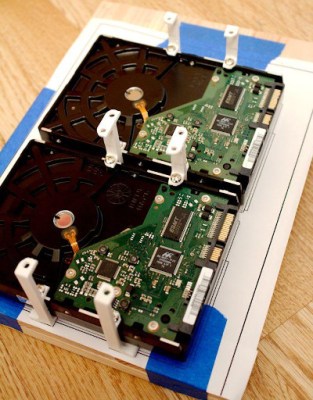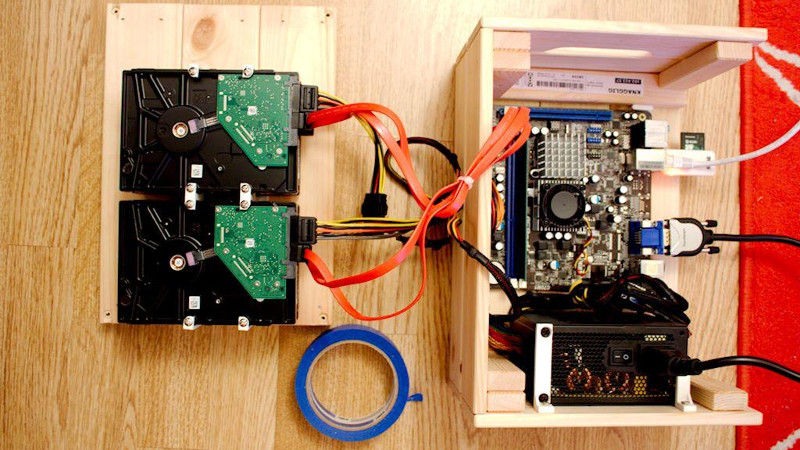Readers who took part in the glory days of custom PC building will no doubt remember the stress of having to pick a case for their carefully-curated build. You may have wanted to lower the total cost a bit by getting a cheap case, but then you’d be stuck looking at some econo-box day in and day out. Plus, how do you post pictures online to boast about your latest build if there are no transparent windows and a lighting kit?
While some may have spent more time choosing their lighted case fans than their optical drive, [Miroslav Prašil] was surely not one of them. When he decided to build a new NAS for his home network, [Miroslav] decided he wanted to put all his money into the device’s internals, and house his build in a wooden storage crate from IKEA. While the low cost was certainly a major factor in the decision, it turns out the crate actually offers a decent amount of room for hardware components. As an added bonus, it doesn’t look completely terrible sitting out in the living room.
 In a detailed series of posts on his blog, [Miroslav] walks us through the entire process of building what he has come to call the “NAScrate”. Wanting gigabit Ethernet and a real SATA controller, [Miroslav] went for the ASRock C70M1, a Mini-ITX board with integrated dual-core AMD processor. While not exactly a powerhouse, it will certainly wipe the floor with the fruit-inspired single board computers that so often dominate these types of builds.
In a detailed series of posts on his blog, [Miroslav] walks us through the entire process of building what he has come to call the “NAScrate”. Wanting gigabit Ethernet and a real SATA controller, [Miroslav] went for the ASRock C70M1, a Mini-ITX board with integrated dual-core AMD processor. While not exactly a powerhouse, it will certainly wipe the floor with the fruit-inspired single board computers that so often dominate these types of builds.
To get his clearances worked out, [Miroslav] rendered the entire build in OnShape, which gave him enough confidence in his design to move on to actual construction. The build involves several 3D printed parts, most notably some clever hard drive mounting brackets which allow the drives to be stacked into a space-saving arrangement while still leaving room for airflow between them.
[Miroslav] deftly avoids any religious debates by leaving off his particular choice for software and operating system on his newly constructed NAS, but he does mention that something like FreeNAS would be a logical choice.
While this may be the first wooden one we’ve covered so far, home servers in general are a favorite project for hackers, from budget-friendly scratch builds all the way up to re-purposed enterprise hardware.
















Looks like it would have enough horsepower to do some moderate transcoding for DLNA as well. Not bad.
The serviio package works a treat for that. I’ve got a Linux box running an Atom D525, and it does just fine.
Very moderate transcoding. The CPU just barely does SMB at 1Gbps. I’d go with more powerful CPU if transcoding is required.
Simple and clean. I like it.
Choose the bigger 19″ crate and it should fit perfectly in the IKEA Lack Rack :)
One of these days, IKEA might just introduce purpose designed PC cases and 3D printer enclosures.
Then they would be just another enclosure manufacturer. Anyone can use a purpose-manufactured object for it’s intended purpose. It’s more fun to hack their livingroom decorations and share the results online.
Computers are so small these days, there’s literally few places one can’t put them.
I’m doing exactly this with an old atom board for a router. I drilled a hole for a pushbutton power switch at the top, and then secured one of those HD44780 LCD devices to the front handle hole with thumbtacks. Have it talking to LCDproc. PicoPSU and you’re good to go.
Yeah, PicoPSU would make my life so much easier. (Or I could fit more drives in) But the price is the limit here.
What happened to EMI/RF shielding? Is that not a thing anymore?
I’d wager the ~1/4 wood this crate is made out of is at least a good EMI shield as the paper-thin sheet metal a cheap PC case is made off. From the original article it sounds like there’s a “lid”, but I don’t see a picture of it in place.
Though it’s kind of beside the point, modern PC hardware is designed with low emissions (Class B) in mind anyway.
The resistivity and the size of any openings are more important than the thickness of the shielding material.
More importantly, shielding isn’t just to prevent the computer from interfering with other ‘devices’. It’s also to protect it from external noise sources. Such as the ignition noise generated by the wanker across the road who likes to rev the bollocks out of his vintage motorcycle…
I’d take that bet!
There are so so many computer cases made out of plastic now days. Big and small. I really don’t see any shielding done on these costly cases.
That’s true for aftermarket / builder cases because they don’t have to meet any compliances. But crack open any Dell or HP and you’ll see sheet metal, EMI fingers, and conductive paint everywhere.
Precisely.
In the EU, it is the system integrator’s responsibility to ensure that the assembled system complies with the EMC directive. I believe the situation in much the same in the US under the relevant FCC regulations.
You could always coat the inside with tin foil and ground it.
When computers become paranoid.
You can laugh, but that is precisely how a lot of custom wooden cases are shielded.
Medium gauge aluminium foil ‘glued’ to the wood and grounded.
Sadly, this is a culture where an unenclosed PCB without even screw holes to ease the mounting of that PCB in an enclosure is commonly considered a finished product. Having even a wooden case is a luxury. I love this so called “maker movement” but nothing is perfect. Some wisdom that was commonplace to previous generations has definitely been lost.
my personal favorite is the screw holes that do not account for a fastener to have a head or a barb or anything larger than the OD of the screw shaft, arduino and pi are good for this, I have another board that if you put a screw in it, it crushes a smt cap
brilliant
Ah yes. The good old creepages and clearances issue…
PCB designers do sometimes forget that the hole isn’t the ‘component’. It’s the stand-off and the screw or other fastening which fits into it which are the ‘components’.
Not for hobbyist builds.
All of mine are in steel cases as I dabble with radio and things will start crashing when I crank up the power.
Nas4free (https://www.nas4free.org/) would be the logical choice nowadays since iX Systems decided to more or less strangle freenas by commercialization (see https://www.nas4free.org/wiki/#history or https://en.wikipedia.org/wiki/NAS4Free#History).
Aaargh, what were you thinking with the PSU install? At least rotate 90 degrees so exhaust points to open space.
I think he did alright in that regard. It looks like the back of this case is wide open. As he has it I would expect the PSU to suck in cool air from it’s mesh, side-panel, only slightly heat that air and then blow the still-cool-enough air across the motherboard. Most of this air I would expect to hit the opposite wall, turn and exit out the back of the case. Meanwhile, on the PSU side cool air would get sucked in through the open back to replace that which is sucked into the PSU.
If he pointed the PSU out as it is in a normal case he would lose that airflow across the motherboard.
Now.. if he totally enclosed it by adding a back panel… then he would just be recycling his increasingly hot air. That would be an issue.
As it is I think the greater issues are the lack of a support to the motherboard connectors and the lack or RF shielding.
There’s only one 90* rotation that results in the exhaust pointing out the open side.
Hey, Miroslav here, author of said NAS. (BTW just found out about this post from the increased visits to my blog)
Yeah, the rotation isn’t ideal and the only reason why is it rotated that way is because the cables (that are going out of the PSU on the bottom side) would be bended sharply (or wouldn’t fit at all) in that position.
Besides the load on the PSU is way too low and the PSU fan is just off. It won’t turn on unless certain threshold is crossed, which never happens in my setup.
So yeah, it isn’t ideal but it isn’t too bad from practical standpoint. But I understand your concern, it bugs me too)
> Plus, how do you post pictures online to boast about your latest build if there are no transparent windows and a lighting kit
Apparently sleeper-PCs are a thing, and I myself own an old IBM workstation case from the early 90’s with modern parts, and water-cooling. I spray painted the insides with black but kept the outside original, it even has the floppy drive still on there (but non-functional.
If you press the ‘Turbo’ button will it slow your i7 down to 4.77 MHz?
What if the turbo button started a dos box emulator?
Me I like the open case way.
Both my main computers are open frame.
One is a 65 Tera. bite server.
My server is in the process of getting redone.
I will be going to a Orange PI Win with 2T of ram. The hard drives will be controlled by a ESP32. Yes it is a web based server. So you have to go and turn on the group of drive you want to get the data off. And yes Almost half the drives are backups. There are over 26 hard drives, 160Gig all the way to 4T. 4 hard drives are on at a time to a max of 8 hard drives.
And then there is my main gaming computer.
They are both on a thin sheet of plywood.
Heat flow is done with fans placed in the right spots and hidden as best as possible.
I all so really like the look of the open computers. If it is done right.
Google uses this open case solution for there servers.
But with an aluminum frame.
“Readers who took part in the glory days of custom PC building…” What is that supposed to mean? If you think people don’t build their own PCs anymore, you’re sorely mistaken.
He’s a ‘reporter’.
Is he running free nas from a SD card on an Adapter why not get a $2 usb thumb drive lower the profile
Hey Dave, I was running it from the SD card, because the thumb drive that I planned to use died. It was a temporary solution to get it running, I’m actually not using the NAS right now, I’ve used it for couple weeks as a temporary storage while I was upgrading my HP Microserver based NAS.
If you’re looking for more horsepower in an Ikea…
http://coyoteridgeobservatory.blogspot.com/